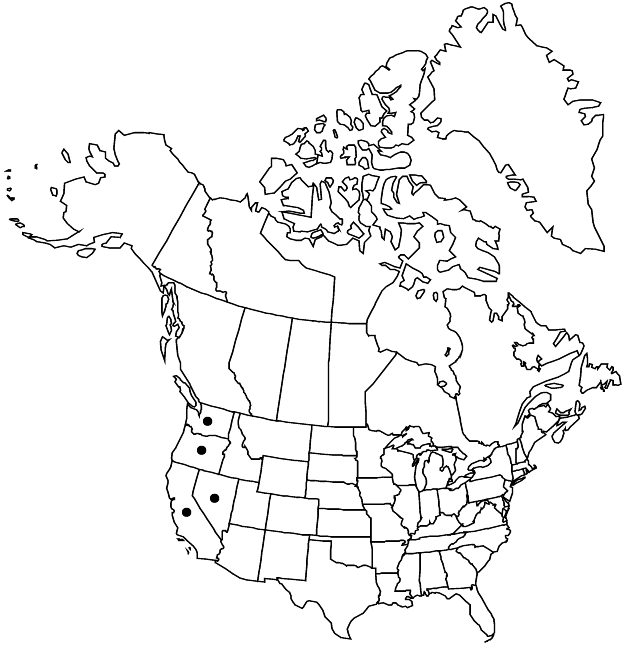Eriogonum nudum
Trans. Linn. Soc. London 17: 413. 1836.
Herbs, mostly erect, infrequently scapose, (0.5–)1–15(–20) × 0.5–3 dm, glabrous or floccose to tomentose, usually greenish, occasionally grayish. Stems spreading to erect, with or without persistent leaf bases, up to 1/4 height of plant; caudex stems absent; aerial flowering stems erect to spreading, slender to stout, solid or hollow, occasionally fistulose, 0.3–4(–10) dm, glabrous or lanate to tomentose or floccose. Leaves basal or sheathing up stem 0.5–4 dm; petiole 1–10 cm, glabrous or tomentose; blade oblanceolate to elliptic or ovate, 1–6 × (0.3–)1–4 cm, densely white-lanate or tomentose abaxially, tomentose to floccose or subglabrous to glabrous adaxially, margins plane or undulate-crisped. Inflorescences cymose, rarely umbellate or capitate, 2–100(–150) × 2–40(–80) cm; branches usually dichotomous, glabrous or tomentose to floccose or sparsely pubescent; bracts 3, scalelike, 0.5–3(–5) mm. Peduncles absent. Involucres 1 per node or 2–10 per cluster, turbinate to turbinate-campanulate, (2.5–)3–5(–7) × (1.5–)2–4 mm, glabrous, tomentose, or sparsely pubescent; teeth 5–8, 0.2–0.6 mm. Flowers (1.5–)2–4 mm; perianth white or yellow, sometimes pink or rose, glabrous or pubescent; tepals connate proximal 1/4, monomorphic, oblong to obovate; stamens exserted, 2–5 mm; filaments pilose proximally. Achenes light brown to brown, 1.5–3.5 mm, glabrous.
Distribution

Calif., Nev., Oreg., Wash., nw Mexico.
Discussion
Varieties 13 (13 in the flora).
Several local groups of Native Americans in California used members of this species in a variety of ways. S. A. Barrett and E. W. Gifford (1933) and S. M. Schenck and E. W. Gifford (1952) reported the consumption of raw young stems that are rather moist and tasty, although there is a sour aftertaste. The Kawaiisu used the hollow stems (probably var. westonii, rather than var. pauciflorum) as drinking tubes and as pipes (M. L. Zigmond 1981). Zigmond reported also that the roots of var. pauciflorum are used as an infusion for coughs.
Members of Eriogonum nudum are food plants for the Bauer’s dotted-blue butterfly (Euphilotes baueri), the Pacific dotted-blue (E. enoptes), the gorgon copper (Gaeides gorgon), and the Mormon metalmark (Apodemia mormo).
Selected References
None.
Lower Taxa
Key
| 1 | Involucres and inflorescence branches tomentose to floccose; leaves usually basal | > 2 |
| 1 | Involucres and inflorescence branches glabrous or, if pubescent, leaves sheathing up stems | > 3 |
| 2 | Perianths white; flowering stems lanate to tomentose; leaf blades 2-3.5 cm; s Sierra Nevada | Eriogonum nudum var. regirivum |
| 2 | Perianths yellow or white to rose; flowering stems tomentose to floccose; leaf blades 2-4 cm; s Oregon, n California, wc Nevada | Eriogonum nudum var. oblongifolium |
| 3 | Leaves sheathing up stems, margins often strongly undulate-crisped | > 4 |
| 3 | Leaves basal, margins plane or slightly undulate-crisped | > 8 |
| 4 | Flowering stems tomentose | > 5 |
| 4 | Flowering stems glabrous | > 6 |
| 5 | Perianths pubescent; flowers 1.5-2 mm; involucres 3-4 mm; Sierra Nevada, California | Eriogonum nudum var. regirivum |
| 5 | Perianths glabrous; flowers 3-4 mm; involucres 4-6 mm; Coast Ranges, California | Eriogonum nudum var. decurrens |
| 6 | Leaf blades densely lanate abaxially, tomentose adaxially; involucres 5-10 per cluster; Sierra Nevada, California | Eriogonum nudum var. murinum |
| 6 | Leaf blades tomentose abaxially, less so to floccose, glabrous, or nearly so adaxially; involucres 1 per node or 2-5 per cluster; widespread, Coast Ranges, California | > 7 |
| 7 | Flowering stems occasionally fistulose; involucres (2-)3-5 per cluster; perianths white to pink, rarely yellowish | Eriogonum nudum var. auriculatum |
| 7 | Flowering stems strongly fistulose; involucres 1 per node; perianths pale yellowish white to yellow or white | Eriogonum nudum var. indictum |
| 8 | Involucres 1(-2) per cluster | Eriogonum nudum var. westonii |
| 8 | Involucres 2-10 per cluster | > 12 |
| 9 | Flowering stems fistulose; perianths yellow, infrequently white; c California | Eriogonum nudum var. westonii |
| 9 | Flowering stems not fistulose or, if so, plants of sw California; perianths white, rarely yellow | > 10 |
| 10 | Perianths pubescent or, infrequently, glabrous; s California | Eriogonum nudum var. pauciflorum |
| 10 | Flowers glabrous; sw Oregon, n California, Nevada | > 11 |
| 11 | Leaf blades 1-5 cm; sw Oregon, n California (including w slope of Sierra Nevada), Washington | Eriogonum nudum var. nudum |
| 11 | Leaf blades 1-2 cm; Sierra Nevada of California and adjacent desert ranges of wc Nevada | Eriogonum nudum var. deductum |
| 12 | Perianths pubescent, often yellow | > 13 |
| 12 | Perianths usually glabrous abaxially, white, rarely yellow | > 14 |
| 13 | Flowering stems not fistulose; leaf blades floccose or glabrous adaxially, margins plane; plants of nonaridregions | Eriogonum nudum var. pubiflorum |
| 13 | Flowering stems slightly to distinctly fistulose; leaf blades tomentose to floccose adaxially, margins undulate-crisped; plants of arid regions | Eriogonum nudum var. westonii |
| 14 | Inflorescences capitate or nearly so; alpine, Sierra Nevada | Eriogonum nudumvar. scapigerum |
| 14 | Inflorescences cymose or, if capitate, not alpine. | > 15 |
| 15 | Involucres 1(-2) per cluster, 5- 7 mm; mountains of s California | Eriogonum nudum var. pauciflorum |
| 15 | Involucres 2-10 per cluster, 3-5 mm; mountains and foothills of c and n California or coastal bluffs. [16. Shifted to left margin—Ed.] | > 16 |
| 16 | Inflorescences cymose and branched 2 or more times; involucres 2-5 per cluster; mountains and foothills of c and n California, Oregon, and Washington. | Eriogonum nudum var. nudum |
| 16 | Inflorescences capitate or cymose and branched 1-2 times; involucres 5-10 per cluster; coastal bluffs, sw Oregon, ne California | Eriogonum nudum var. paralinum |